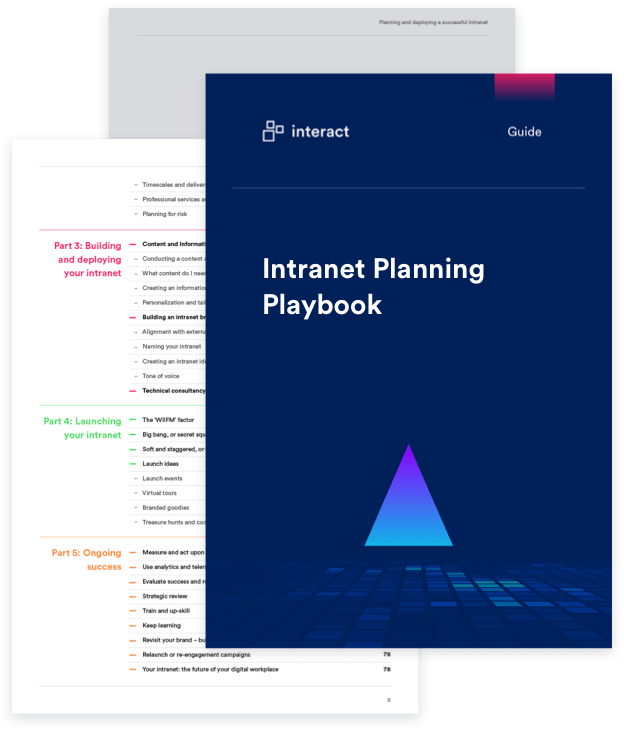A finger on the pulse: the role of pulse surveys in internal comms

Communication in business needs to be a two-way street. It’s internal comms’ responsibility to nurture this type of culture: communicating the plans and proposals from senior level management while taking on feedback and reactions from the workforce. So how do you do execute this successfully?
Traditionally, annual surveys have been used to gauge the thoughts and feelings of staff. While these surveys may contain a lot of information for internal comms to work with, they can be long and tedious, and regarded by many employees as a necessary chore. With other tasks taking priority, these surveys may be finished last minute or filled in randomly in order to complete them.
While a lot of organizations see these types of surveys as a necessary part of determining the opinions of staff, there is a much more effective and time-friendly alternative: pulse surveys.
Pulse surveys can measure engagement and track change very quickly (hence the name: they help you check the ‘pulse’ of the business). They give you the data and metrics needed to chart your progress and provide a great way of getting the go-ahead for new engagement and communication strategies.
A quick click is all that’s needed for an employee to give an opinion on a wide variety of subjects: how they feel about their job, their opinion on the content from the internal comms department, whether they feel valued… and other questions which help build a picture of your people and your company culture.
Does your employee feedback matter?
What are pulse surveys?

Pulse surveys are a great way of focusing on a particular area for improvement. They are short, concise, and very specific. You can use one question or ten, and the data will provide an insight into the thoughts, feelings, engagement, and understanding of the employee.
They also allow the employee to put their opinion across on organization changes, company news and how effective the training provided is.
And the best thing is that pulse surveys are quick to do, and the data that comes off them can be instantly collated and tracked throughout the year.
Why use pulse surveys?
Pulse surveys give you frequent, timely feedback. Ranging from one to ten questions, they provide a number of benefits to an organization and are an improvement from the longwinded surveys of old.
There are many benefits to pulse surveys. These are some of the many reasons to implement pulse surveys into your internal comms strategies:
Improves employee engagement – if you have workers who are regularly providing feedback, both good and bad, you have engaged employees – an asset to any business. Engaged workers are happier, work harder and have a longer career in the organization than someone who lacks engagement.
Boosts a culture of continuous improvement – pulse surveys allow you to get feedback quickly, allowing you to make amendments accordingly.
Allows for analysis of improvements over a period of time – being able to receive feedback on adjustments you make to tech, policies, procedures, training, etc, can be analyzed week on week, month on month with the help of pulse surveys.
Provides a real-time measurement of employee happiness – pulse surveys take a short amount of time to send, and moments to respond to. This real-time feedback is a great way of tracking employee satisfaction over a period of time.
High response rates – asking a few questions regularly gets better response rates than surveys that take much longer. If the worker can see improvements being made off the back of the responses, this will create a great system of survey > response > action within the organization.
Encourages open communication – when the worker feels listened to, it promotes a more open culture. This openness will provide you with insights, thoughts, and ideas that you may not have had access to otherwise.
Quicker turn-around time compared to annual surveys – short and frequent questions are quicker to produce than lengthy annual surveys.
Steers employees into focusing on specific topics and areas of working life – asking questions about areas as diverse as training, communal areas or their own personal well-being allows the employee to reflect on any issues. This can encourage good habits and mindfulness about their relationships with colleagues, professional attitude, and personal growth.
Does your employee feedback matter?
Announcing your pulse survey

Before you deliver your survey, it’s important to announce your plans to your organization. Make sure management and leadership are aware of the benefits of pulse surveys, and they’re on board with your strategy.
It’s also vital that you communicate it with your employees. If the idea has been clearly explained to them, they’ll already have a clear idea what to do when they start seeing random questions, or links to a short survey in their email.
How to use a pulse survey
Aside from the questions you ask (which we’ll explore shortly), there’s a number of things you have to get right in order to get the best out of your pulse survey:
- The frequency
- The length
- The response choices
Frequency: The use of pulse surveys is flexible, but best practice dictates that they should be used within every email from internal communications to the workforce. Even if it’s just one question at the beginning of the email, having pulse surveys as part of your contact with the organization means that providing and gathering feedback becomes a habit for the whole company.
This constant presence also demonstrates care for the staff perspective. Where annual surveys could be seen as a ‘special occasion’, the pulse survey acts like a constant checking in on how the employee thinks and feels about the environment and culture that they work in.
Length: Your internal communications strategy should incorporate the inclusion of one to ten survey questions per staff email and include pertinent questions regarding the organization. Try and steer clear of putting too many questions in your pulse survey. It’s important to maintain a light touch, so lengthier questionnaires should be left for the annual survey.
Response scales: There is a wide choice of response scales to choose from. It’s so important to make sure the scale you choose works with the question you ask. Match the wrong scale to the question posed, and you risk people disengaging from the exercise altogether.
Binary – also known as the dichotomous scale, this is the simple yes/no or thumbs up/thumbs down option, and best suited to questions which could only have a yes or no answer, like ‘Did you attend the work social on Wednesday?’
Star rating – this is an easily identifiable visual scale and used on questions that are based on standards or satisfaction. For example, ‘Rate the training course you took last week’.
The Likert scale – the “Very unhappy | Somewhat unhappy | Neutral | Somewhat happy | Very happy” works really well with capturing people’s responses. The emoji-style faces showing a range of reactions to the question is also a variation of the Likert scale.
The number scale – the number scale can give the responder more precision over their answer, ie: ‘Out of ten, how happy are you with the changes to the holiday entitlement policy?’
Although it’s not necessary all the time, it’s a good idea, where possible, to include an opt-out option for anyone who isn’t happy to provide an answer.
Does your employee feedback matter?
What questions should I ask in a pulse survey?

What questions you ask in your pulse survey will be based around your internal comms strategy. They should also include any big changes in the company like new tech implementations or modifications to corporate policies.
As a basic guide, the following questions are some of the most useful ‘broad’ questions.
- “How happy are you at work?”
This will tell you whether your employees generally happy in their job if they enjoy where they work and what they do.
- “I know what constitutes good performance in my role.”
It’s important for your employees to feel like their job role is clearly defined, so make sure they have clear goals and objectives and know how their performance is assessed.
- “I have access to everything I need to perform to the best of my ability.”
This allows you to see whether your employees have the equipment and resources to fulfill their role. It will also let you see whether there is anything holding them back.
- “I receive meaningful recognition for doing good work.”
This question will let you know if your employees feel valued and if the efforts they put in and the achievements are appreciated.
- “I feel comfortable giving opinions and feedback to managers.”
Finding out opinions the employees have of management will allow you to have an idea of how open your company culture is.
- “On a scale of 1-10, how would you rate your work-life balance?”
This will allow you to check whether employees feel like too much is expected of them. Their working hours may be too long or the working culture too demanding or stressful.
- “My personal values align with the company’s vision and mission”
Finding out if employees share your company values or if they feel connected to what your company stands for is so important when it comes to getting your external and internal branding right. It may be a case that the vision of your organization isn’t clear or in any way promoted.
- “How likely are you to recommend your organization’s products or services to a friend?”
With this question, you’ll be able to work out if your employees are proud to work for your company and if they believe in what your company does or produces.
- “I am given opportunities to learn and develop my skills”
Do employees feel like they are encouraged to learn new skills? Is there enough focus on personal development by the company and by managers?
- “I can see clear career progression in my role”
For an organization to grow, employees should feel like there are sufficient opportunities to progress within the company. Are managers supportive of career development? Do employees feel like they have a future at the company?
Does your employee feedback matter?
What to do after your pulse survey responses comes back

The survey doesn’t stop at the feedback. It’s what you do with the feedback that counts. Here are the three main points to action, once you’ve got all those valuable responses back.
Act on the feedback! An important thing to remember about pulse surveys: in order for them to be effective, they need to be acted on. Getting your workforce to regularly answer questions relies on them seeing the results from your surveys. If you don’t act upon the feedback, you undermine any engagement and risk the chances of getting any more reliable data back in future surveys.
Share the results: Sometimes if the data is confidential, it’s best to keep it that way. But a lot of the time, it is a good idea to share the results. So, if you’ve had a fairly negative response to a new implementation, you can share the results with the organization and announce plans to improve matters. This is a great way of building on that two-way conversation: workers see the overall response, are informed of improvements and are kept abreast of developments.
Rinse and repeat: The feedback has given you pointers on how to improve the subject matter. You’ve made the improvements, now it’s time to check up on what your workers think. Send the survey out again at an appropriate time, and see what the general opinions are. One of the great benefits of a pulse survey is being able to track improvements. While you think you may have fixed a problem, you’ll only get confirmation when you ask the people whom those changes affect.
To find out more about polls and other techniques to connect with workers using our intranet software from Interact, read our blog on how eleven of our customers mastered employee engagement here.

